The transformation of news broadcasting encompasses the significant changes in the production, distribution, and consumption of news driven by technological advancements, particularly the internet and mobile devices. Traditional methods, such as television and radio, have evolved to include online platforms and social media, leading to a shift in viewership from scheduled broadcasts to on-demand access through apps and websites. This evolution has resulted in declining traditional viewership numbers and raised ethical concerns regarding misinformation and fake news. News organizations face the challenge of maintaining credibility while adapting to new formats and changing audience expectations, highlighting the interplay between technology, viewership trends, and ethical standards in the modern news landscape.

What is the Transformation of News Broadcasting?
The transformation of news broadcasting refers to the significant changes in how news is produced, distributed, and consumed. This transformation has been driven by technological advancements, particularly the rise of the internet and mobile devices. Traditional broadcast methods, such as television and radio, have evolved to include online platforms and social media.
Viewership has shifted from scheduled broadcasts to on-demand access. Audiences now prefer consuming news through apps and websites at their convenience. This change has led to a decline in traditional viewership numbers.
Ethical considerations have also emerged due to the rapid spread of information online. Misinformation and fake news have become prevalent issues. News organizations are now challenged to maintain credibility while adapting to new formats and audience expectations.
Overall, the transformation of news broadcasting encompasses technological innovations, changing audience behaviors, and evolving ethical standards.
How has technology influenced the evolution of news broadcasting?
Technology has significantly influenced the evolution of news broadcasting by enhancing accessibility and immediacy. The advent of the internet allowed news to be disseminated in real-time. Traditional broadcasting methods, like radio and television, were limited by time slots and geographical reach. Digital platforms have enabled 24/7 news coverage and global access. Social media has transformed how news is shared and consumed, allowing for immediate audience engagement. Data analytics tools help news organizations understand viewer preferences and tailor content accordingly. Additionally, advancements in mobile technology have made news available on smartphones and tablets. According to a Pew Research study, 86% of Americans get news from digital devices. This shift represents a fundamental change in how news is produced and consumed.
What are the key technological advancements shaping news broadcasting?
Key technological advancements shaping news broadcasting include digital streaming, artificial intelligence, and mobile journalism. Digital streaming allows real-time news delivery to global audiences. This technology has increased viewer engagement and accessibility. Artificial intelligence enhances content curation and automates news production. AI tools analyze data to identify trending topics and personalize news feeds. Mobile journalism enables reporters to create and share news using smartphones. This advancement has made news coverage more immediate and versatile. Additionally, social media platforms facilitate direct interaction between news organizations and audiences. These advancements collectively transform how news is produced, distributed, and consumed.
How do these technologies enhance the news delivery process?
Technologies enhance the news delivery process by improving speed, accessibility, and engagement. Digital platforms allow for real-time updates, delivering news as events unfold. Mobile applications enable users to receive notifications instantly, increasing user engagement. Social media channels facilitate broader distribution, reaching diverse audiences quickly. Data analytics tools help news organizations understand audience preferences, tailoring content accordingly. Video streaming technologies provide immersive experiences, enhancing viewer connection. Artificial intelligence can curate personalized news feeds, ensuring relevance for individual users. These advancements collectively transform how news is consumed and interacted with in the digital age.
What changes have occurred in viewership patterns?
Viewership patterns have shifted significantly due to technological advancements. Traditional television viewership has declined as audiences migrate to digital platforms. Streaming services have gained popularity, offering on-demand content. Social media has become a primary source for news consumption. Younger demographics increasingly prefer mobile devices over traditional screens. Live news broadcasts now compete with online updates for viewer attention. According to a Pew Research Center study, 55% of U.S. adults get news from social media. This indicates a fundamental change in how news is accessed and consumed.
How has audience engagement shifted with the rise of digital media?
Audience engagement has shifted significantly with the rise of digital media. Traditional media relied on passive consumption, whereas digital platforms encourage interactive participation. Viewers now engage through comments, shares, and likes on social media. This shift allows for real-time feedback and dialogue between audiences and content creators. A study by the Pew Research Center indicates that 62% of Americans get news from social media. This statistic highlights the importance of digital channels in shaping audience interaction. Moreover, digital media enables personalized content delivery, enhancing user engagement. Overall, digital media has transformed audience engagement from passive to active participation.
What demographics are most affected by these changes in viewership?
Younger audiences, particularly those aged 18 to 34, are most affected by changes in viewership. This demographic increasingly prefers digital platforms over traditional television. Research shows that 60% of this age group consumes news primarily online. Older viewers, aged 50 and above, still rely heavily on television for news. However, they are gradually adapting to online sources as well. The shift in viewership habits is evident across various studies, indicating a significant transformation in news consumption.
What ethical considerations arise from the transformation of news broadcasting?
The transformation of news broadcasting raises several ethical considerations. One major concern is the accuracy of information. With the rise of digital platforms, misinformation can spread rapidly. This challenges traditional journalistic standards. Another issue is the impact of algorithms on news visibility. Algorithms may prioritize sensational content over factual reporting. This can distort public perception and understanding of important issues. Privacy concerns also arise as news organizations collect user data. This data can be used to target audiences, raising questions about consent and transparency. Additionally, the pressure for timely reporting can compromise thorough fact-checking. This can lead to the dissemination of unverified information. Overall, the transformation of news broadcasting necessitates a reevaluation of ethical practices in journalism.
How do technological advancements challenge traditional journalistic ethics?
Technological advancements challenge traditional journalistic ethics by altering how news is produced and consumed. The rise of social media enables rapid information dissemination. This speed can compromise fact-checking processes. Journalists face pressure to prioritize sensationalism over accuracy to attract attention. Additionally, algorithms influence content visibility, potentially skewing public perception. The ability to manipulate images and videos raises concerns about authenticity. Furthermore, the proliferation of misinformation complicates the journalist’s role as a trusted information source. These factors collectively undermine established ethical standards in journalism.
What role does misinformation play in the current news landscape?
Misinformation significantly undermines the credibility of the current news landscape. It spreads rapidly through social media and online platforms. A study by MIT found that false news stories are 70% more likely to be retweeted than true stories. This rapid dissemination leads to public confusion and distrust in legitimate news sources. Misinformation can shape public opinion and influence political outcomes. For example, false narratives during elections have been shown to sway voter behavior. The prevalence of misinformation poses ethical challenges for news organizations. They must navigate the balance between speed and accuracy in reporting.
How do these elements interconnect within the news broadcasting ecosystem?
The elements within the news broadcasting ecosystem interconnect through technology, audience engagement, and ethical standards. Technology enables real-time reporting and distribution of news. This immediacy affects viewership patterns, as audiences expect timely updates. Viewership metrics inform broadcasters about audience preferences and behaviors. These insights guide content creation and presentation styles. Ethical considerations arise from the responsibility to provide accurate and unbiased information. Technology also influences ethical practices, such as the use of fact-checking tools. The interplay of these elements shapes the overall effectiveness and credibility of news broadcasting.
What future trends can we expect in news broadcasting?
Future trends in news broadcasting include increased use of artificial intelligence and automation. AI will enhance content creation and distribution efficiency. Automation will streamline news gathering processes, allowing for real-time reporting. Additionally, personalized news experiences will become more prevalent. Algorithms will curate content based on individual viewer preferences. Live streaming and interactive formats will engage audiences more effectively. The rise of mobile-first news consumption will continue to shape broadcasting strategies. Moreover, ethical considerations will drive transparency and accountability in reporting. These trends reflect the ongoing evolution of news broadcasting in response to technological advancements and audience demands.
How might emerging technologies further change the landscape of news delivery?
Emerging technologies will further change the landscape of news delivery by enhancing personalization and real-time reporting. Artificial intelligence can analyze user preferences to tailor content delivery. This ensures that news is relevant to individual viewers. Additionally, augmented reality and virtual reality can provide immersive experiences for news stories. These technologies allow viewers to engage with content in a more interactive way. Blockchain technology may also enhance transparency in news sources. It can verify the authenticity of news articles and combat misinformation. According to a 2021 Pew Research study, 64% of Americans believe that technology has improved access to news. This indicates a growing acceptance of technological advancements in news delivery.
What ethical frameworks could guide future news broadcasting practices?
Ethical frameworks that could guide future news broadcasting practices include the Society of Professional Journalists (SPJ) Code of Ethics and the RTDNA Code of Ethics. The SPJ Code emphasizes principles like seeking truth, minimizing harm, and acting independently. This code encourages journalists to provide accurate information and avoid conflicts of interest. The RTDNA Code focuses on accountability and transparency in reporting. It stresses the importance of fairness and the need to correct errors promptly. Both frameworks advocate for ethical decision-making in journalism. They serve as guidelines to foster trust and credibility in news broadcasting. Adhering to these ethical standards can help navigate challenges posed by technology and audience expectations.
What best practices should news organizations adopt in this transformed environment?
News organizations should adopt transparency, audience engagement, and fact-checking as best practices in this transformed environment. Transparency builds trust with audiences. It involves clearly disclosing sources and methods. Audience engagement enhances relevance and connection. Organizations should utilize social media to interact with viewers. Fact-checking ensures information accuracy. This practice combats misinformation and upholds journalistic integrity. According to a 2021 Pew Research Center study, 57% of Americans say news organizations should be more transparent about their reporting processes. Emphasizing these practices can strengthen credibility and foster a more informed public.
The main entity of the article is the transformation of news broadcasting. This transformation encompasses significant changes in the production, distribution, and consumption of news, driven by technological advancements such as the internet and mobile devices. Key topics include the shift in viewership patterns from traditional media to digital platforms, the impact of technology on audience engagement, and the ethical considerations arising from the rapid spread of misinformation. The article also highlights future trends in news broadcasting and best practices for news organizations to enhance transparency and credibility in the evolving media landscape.
